Case Study to Analyze the Impact of Multi-Course Project-Based Learning Approach on Education for Sustainable Development
Abstract
1. Introduction
2. Educational Strategy in PBL
3. Research Method
3.1. Study Participants
3.2. Review Phase
3.3. Design Phase
3.4. Implementation Phase
3.5. Observation and Reflection Phase
4. Analysis
5. Result and Discussion
5.1. Description of Evidence-Based Indicator
5.2. Description of Chi-Square Statistics
5.3. Students’ Creative Way of Thinking
5.4. Constraints in the Implementation of Actions
- (a)
- The multi-course project topics should be more diverse and interesting.
- (b)
- Resources available at the laboratory should be sufficient for completing the multi-course projects.
- (c)
- The lab schedule should be modified to teach students to develop their independent learning skills.
- (d)
- More emphasis should be put on the teamwork experience, and laboratory experiments should be modified to have sessions on team-building exercises.
- This paper discusses the step-by-step implementation of MPL which can help attain the competencies required for ESD.
- This paper has analyzed the effects of MPL implementation for two undergraduate-level courses in terms of student performance and also student perception through a survey.
- This paper has also highlighted some of the improvements that can be made in order to make the acquisition of ESD competencies more effective.
- The authors believe that implementing MPL for undergraduate levels is more effective for training and making students aware of always trying to work towards a sustainable future.
6. Conclusions
Author Contributions
Funding
Acknowledgments
Conflicts of Interest
Appendix A


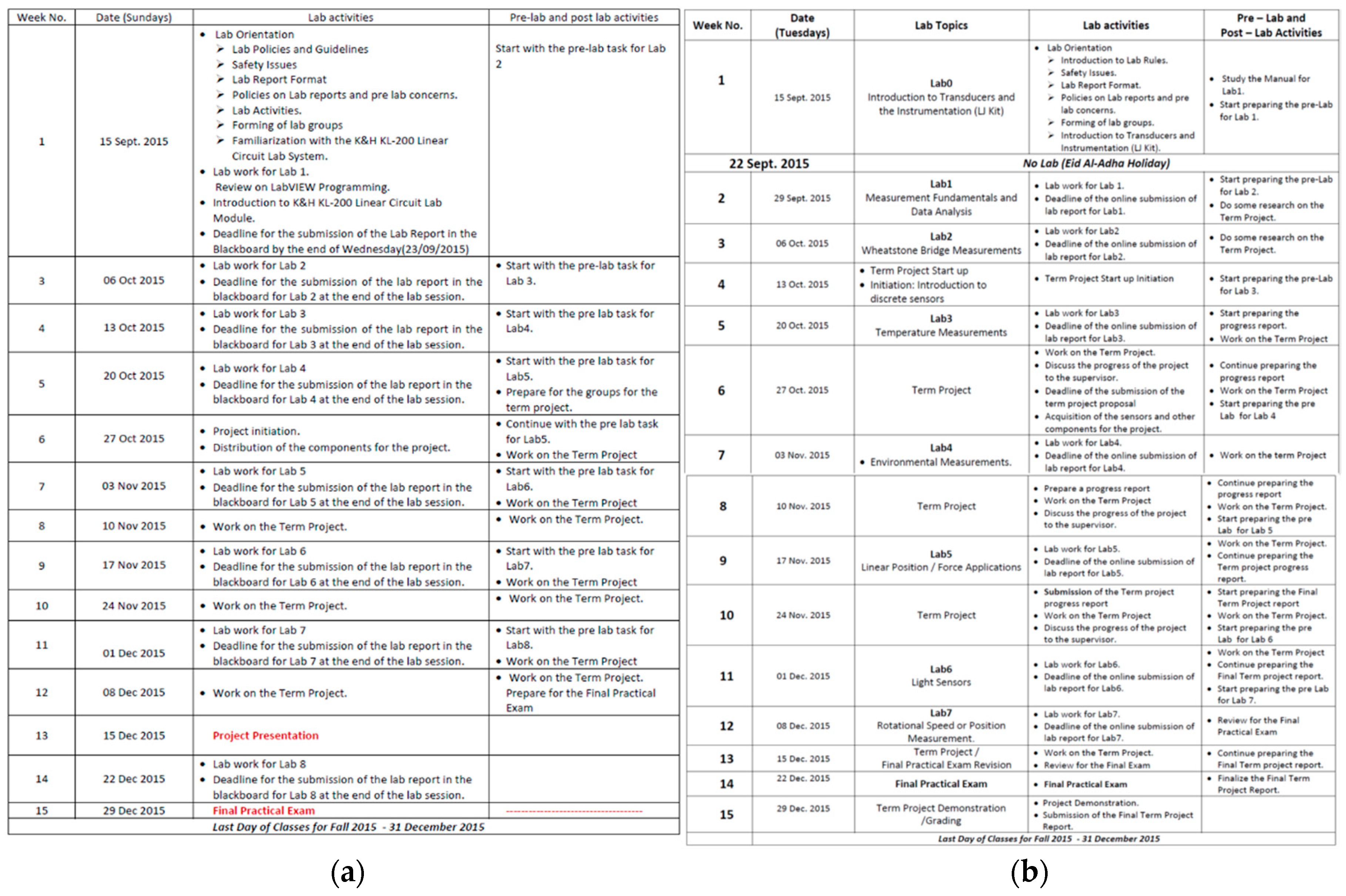
References
- Wiek, A.; Withycombe, L.; Redman, C.L. Key competencies in sustainability: A reference framework for academic program development. Sustain. Sci. 2011, 6, 203–218. [Google Scholar] [CrossRef]
- Van der Leeuw, S.; Wiek, A.; Harlow, J.; Buizer, J. How much time do we have? Urgency and rhetoric in sustainability science. Sustain. Sci. 2012, 7, 115–120. [Google Scholar] [CrossRef]
- Dochy, F.; Segers, M.; Van den Bossche, P.; Gijbels, D. Effects of problem-based learning: A meta-analysis. Learn. Instr. 2003, 13, 533–568. [Google Scholar] [CrossRef]
- Dal, M. Teaching electric drives control course: Incorporation of active learning into the classroom. IEEE Trans. Educ. 2013, 56, 459–469. [Google Scholar] [CrossRef]
- Saghafinia, A.; Ping, H.W.; Uddin, M.N.; Amindoust, A. Teaching of simulation an adjustable speed drive of induction motor using MATLAB/Simulink in advanced electrical machine laboratory. Procedia-Soc. Behav. Sci. 2013, 103, 912–921. [Google Scholar] [CrossRef][Green Version]
- Anuchin, A.; Vagapov, Y.; Belloc, C. Development of curriculum for a postgraduate course on Electric Drives and Motion Control. In Proceedings of the 50th International Universities Power Engineering Conference (UPEC), Stoke-on-Trent, UK, 1–4 September 2015; IEEE: Piscataway, NY, USA, 2018. [Google Scholar]
- Rusu, C.; Radulescu, M.M.; Enikö, S.; Melinda, R.K.; Jakab, Z.L. Embedded motor drive prototype platform for testing control algorithms. In Proceedings of the 2014 International Conference on Applied and Theoretical Electricity (ICATE), Craiova, Romania, 23–25 October 2014; IEEE: Piscataway, NY, USA, 2014. [Google Scholar]
- Santos-Martin, D.; Alonso-Martinez, J.; Carrasco, J.E.-G.; Arnaltes, S. Problem-based learning in wind energy using virtual and real setups. IEEE Trans. Educ. 2012, 55, 126–134. [Google Scholar] [CrossRef]
- Mitchell, J.E.; Canavan, B.; Smith, J. Problem-based learning in communication systems: Student perceptions and achievement. IEEE Trans. Educ. 2010, 53, 587–594. [Google Scholar] [CrossRef]
- Ruuskanen, T.; Vehkamäki, H.; Riuttanen, L.; Lauri, A. An Exploratory Study of the Learning of Transferable Skills in a Research-Oriented Intensive Course in Atmospheric Sciences. Sustainability 2018, 10. [Google Scholar] [CrossRef]
- Schaeffer, K. A multi-course collaborative project: Using technology to learn. J. Fam. Consum. Sci. 2008, 100, 34. [Google Scholar]
- Schahczenski, C.; Ackerman, F. A successful multi-course project. J. Comput. Sci. Coll. 2017, 33, 202–208. [Google Scholar]
- Baochun, X.; Yunlong, S.; Jingqiu, W.; Wei, C. Design and Implementation of Teaching for the Training Project of Multi-course. China Mod. Educ. Equip. 2017, 7. [Google Scholar] [CrossRef]
- Sullivan, G.A.; Hardin, J.-M. The Can Crusher Project: A Multi-Semester Design Project to Enhance Retention of Engineering Skill Sets. In Proceedings of the ASME 2015 International Design Engineering Technical Conferences and Computers and Information in Engineering Conference, Boston, MA, USA, 2–5 August 2015; ASME American Society of Mechanical Engineers: Two Park Avenue, NY, USA, 2015. [Google Scholar]
- Wijayati, N.; Sumarni, W.; Supanti, S. Improving Student Creative Thinking Skills Through Project Based Learning. Kne Soc. Sci. 2019, 2019, 408–421. [Google Scholar] [CrossRef]
- Barrows, H.S. Problem-based learning in medicine and beyond: A brief overview. New Dir. Teach. Learn. 1996, 1996, 3–12. [Google Scholar] [CrossRef]
- Gijselaers, W.H. Connecting problem-based practices with educational theory. New Dir. Teach. Learn. 1996, 1996, 13–22. [Google Scholar] [CrossRef]
- Rekola, J.; Messo, T. Application of problem-based learning method for a course on modeling and control of electric drives. In Proceedings of the IECON 2017-43rd Annual Conference of the IEEE Industrial Electronics Society, Beijing, China, 29 October–1 November 2017; IEEE: Piscataway, NY, USA, 2017. [Google Scholar]
- Barge, S. Principles of Problem and Project Based Learning: The Aalborg PBL Model; Aalborg University Press: Aalborg, Denmark, 2010. [Google Scholar]
- Kolmos, A.; Fink, F.K.; Krogh, L. The Aalborg PBL Model: Progress, Diversity and Challenges; Aalborg University Press: Aalborg, Denmark, 2004. [Google Scholar]
- Jonassen, D.H.; Hung, W. All problems are not equal: Implications for problem-based learning. In Essential Readings in Problem-Based Learning; Purdue University Press: West Lafayette, IN, USA, 2015; pp. 7–41. [Google Scholar]
- Hmelo-Silver, C.E. Problem-based learning: What and how do students learn? Educ. Psychol. Rev. 2004, 16, 235–266. [Google Scholar] [CrossRef]
- Gijbels, D.; Dochy, F.; Van den Bossche, P.; Segers, M. Effects of problem-based learning: A meta-analysis from the angle of assessment. Rev. Educ. Res. 2005, 75, 27–61. [Google Scholar] [CrossRef]
- Lozano, R.; Barreiro-Gen, M.; Lozano, F.J.; Sammalisto, K. Teaching Sustainability in European Higher Education Institutions: Assessing the Connections between Competences and Pedagogical Approaches. Sustainability 2019, 11, 1602. [Google Scholar] [CrossRef]
- Jabarullah, N.H.; Hussain, H.I. The effectiveness of problem-based learning in technical and vocational education in Malaysia. In Education+ Training; Emrald Publishing Limited: Bradford, UK, 2019. [Google Scholar]
- Singer-Brodowski, M.; Brock, A.; Etzkorn, N.; Otte, I. Monitoring of education for sustainable development in Germany–insights from early childhood education, school and higher education. Environ. Educ. Res. 2019, 25, 492–507. [Google Scholar] [CrossRef]
- Nguyen, T.P. Searching for education for sustainable development in Vietnam. Environ. Educ. Res. 2019, 25, 1–13. [Google Scholar] [CrossRef]
- Jones, K.A.; Sharma, R.S. An experiment in blended learning: Learning without lectures. In Proceedings of the 2017 IEEE Conference on E-Learning, E-Management and E-Services (IC3e), Kuching, Malaysia, 16–17 November 2017; IEEE: Piscataway, NY, USA, 2017. [Google Scholar]
- Khandakar, A.; Chowdhury, M.E.; Ahmed, R.; Dhib, A.; Mohammed, M.; Al-Emadi, N.A.; Michelson, D. Portable system for monitoring and controlling driver behavior and the use of a mobile phone while driving. Sensors 2019, 19, 1563. [Google Scholar] [CrossRef]
- Lancaster, H.O.; Seneta, E. Chi-square distribution. Encycl. Biostat. 2005, 2. [Google Scholar] [CrossRef]
- Rao, J.; Scott, A. On simple adjustments to chi-square tests with sample survey data. Ann. Stat. 1987, 15, 385–397. [Google Scholar] [CrossRef]
- Barnett, A.P.; Safai, N.M. Board 101: Project Based Learning for a Mechanical Engineering Major Student: The Sustainability of Internal Combustion Engines (Student Poster). In Proceedings of the 2019 ASEE Annual Conference & Exposition, Tampa, FL, USA, 18 June 2019; ASEE: Washington, WA, USA, 2019. [Google Scholar]
- Chen, C.-H.; Yang, Y.-C. Revisiting the effects of project-based learning on students’ academic achievement: A meta-analysis investigating moderators. Educ. Res. Rev. 2019, 26, 71–81. [Google Scholar] [CrossRef]
- Teff-Seker, Y.; Portman, M.E.; Kaplan-Mintz, K. Project-Based Learning in Education for Sustainable Development: A Case Study of Graduate Planning Students. Case Stud. Environ. 2019. [Google Scholar] [CrossRef]
- Maurer, M.; Bogner, F.X. How freshmen perceive Environmental Education (EE) and Education for Sustainable Development (ESD). PLoS ONE 2019, 14, e0208910. [Google Scholar] [CrossRef]
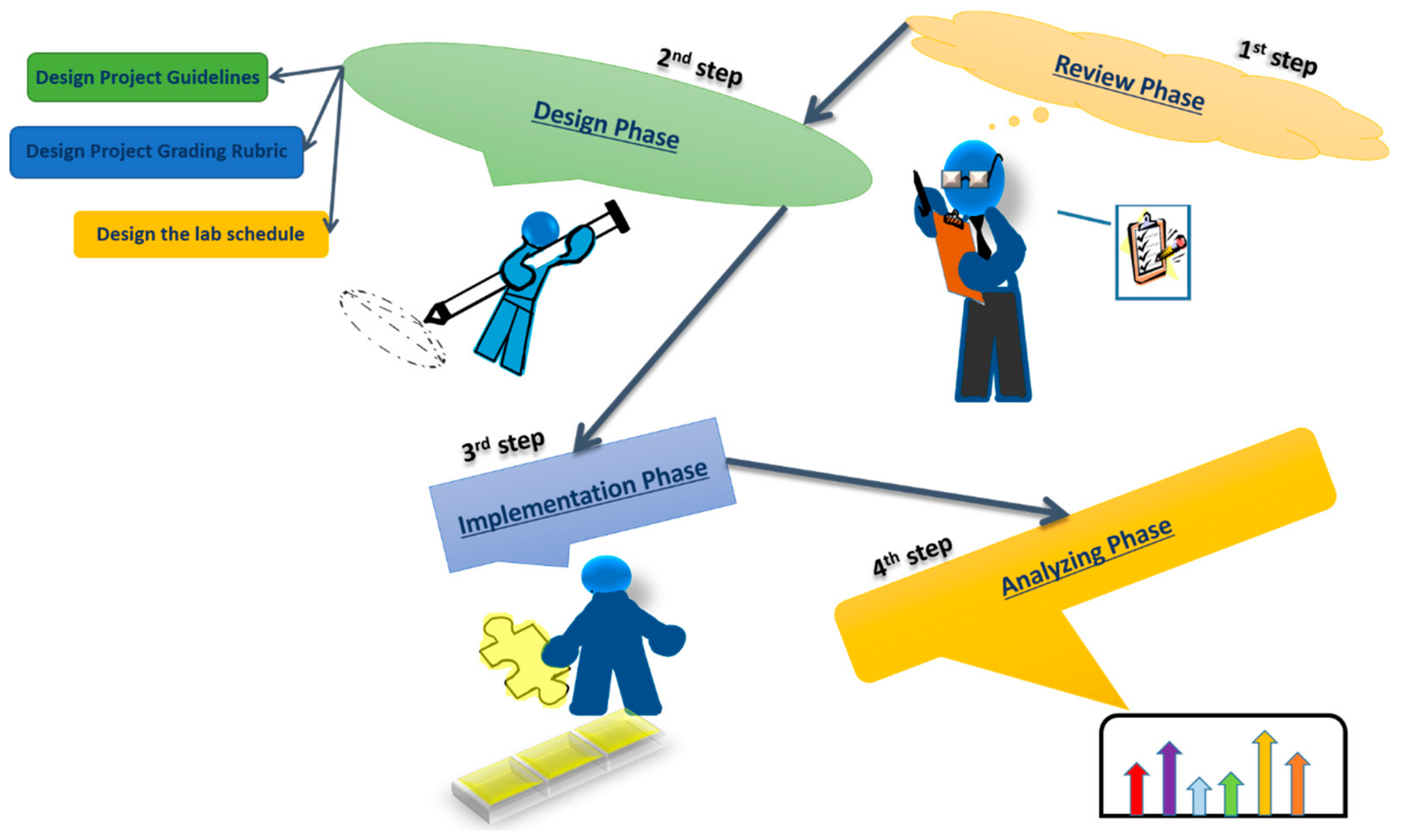
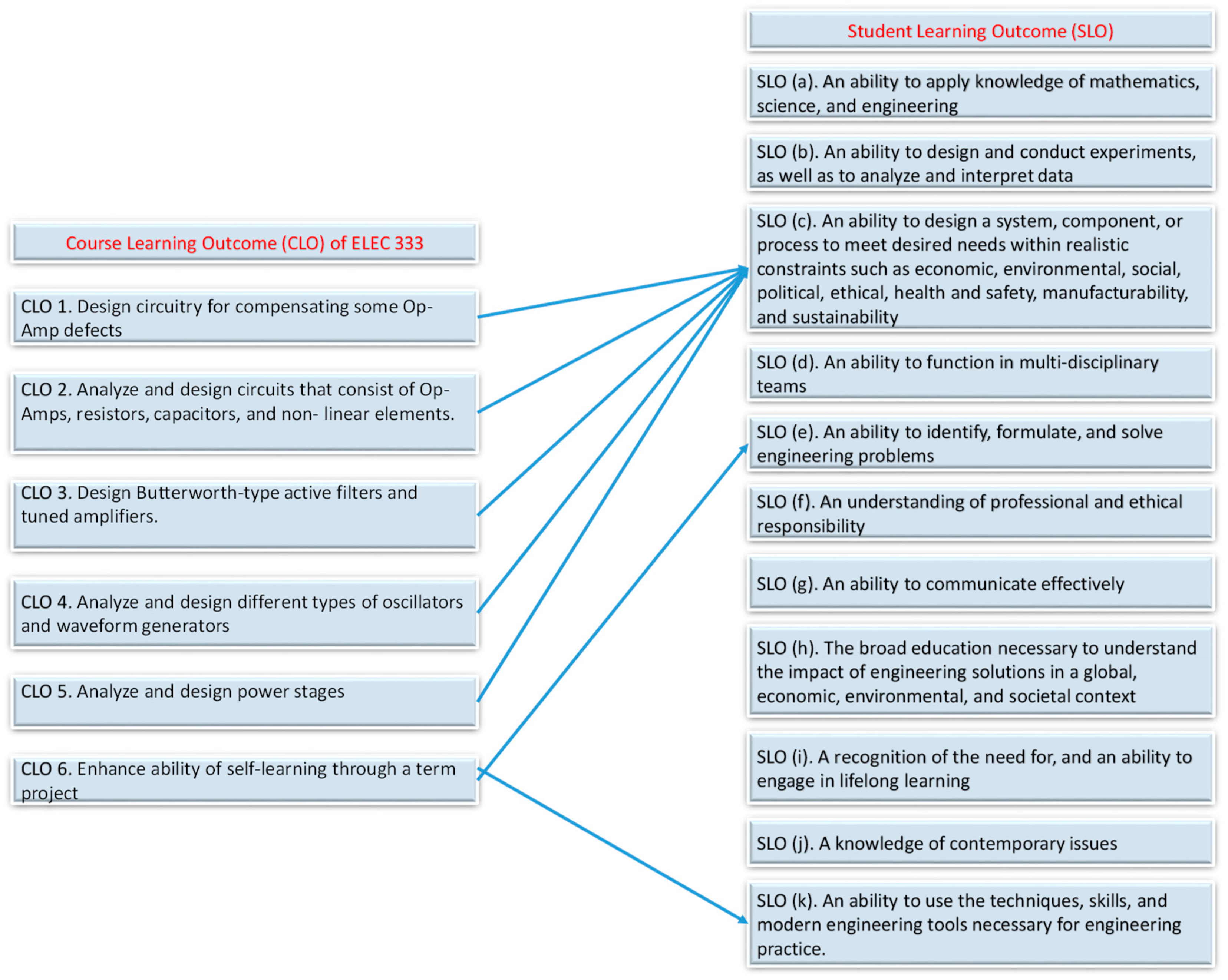
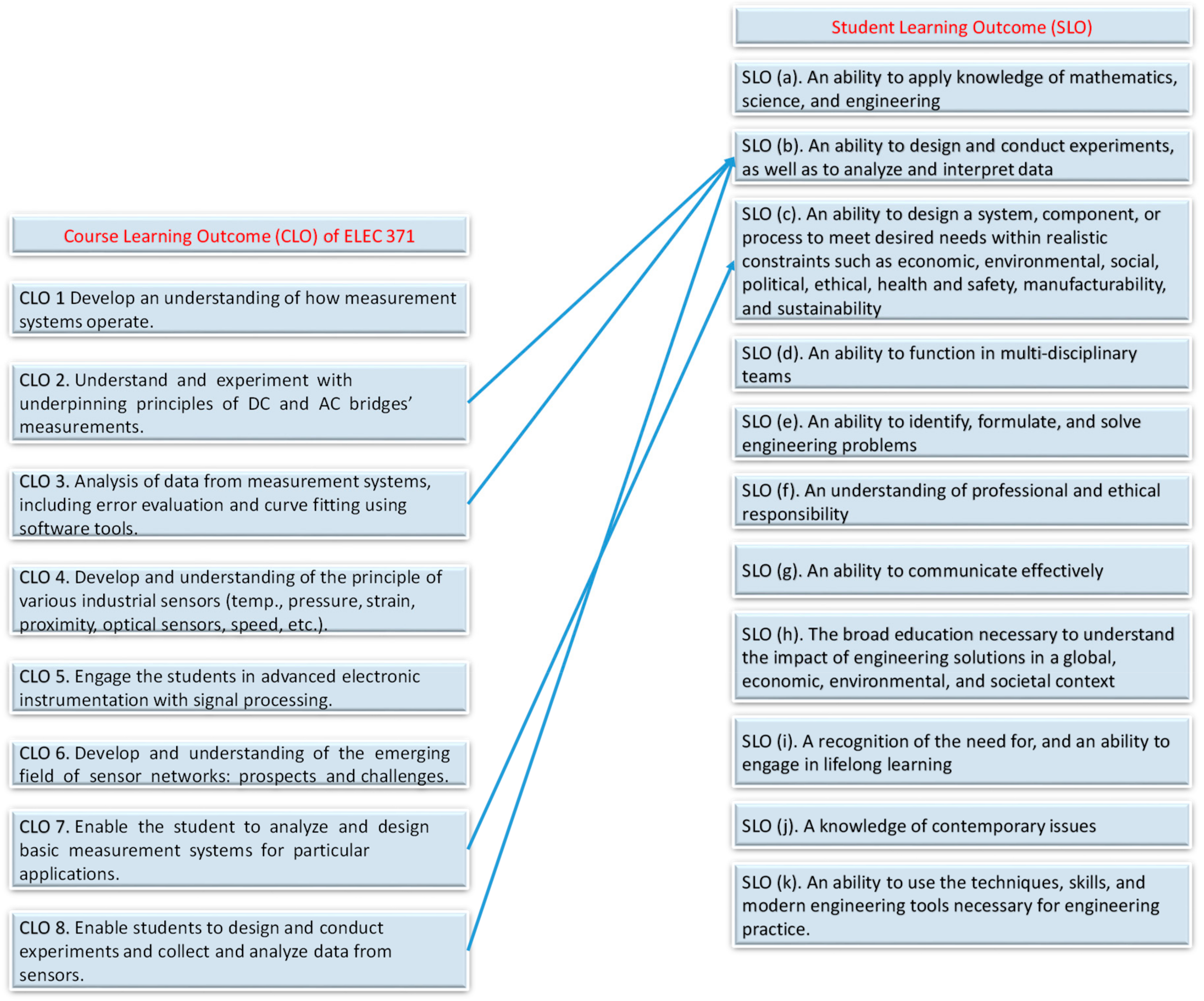
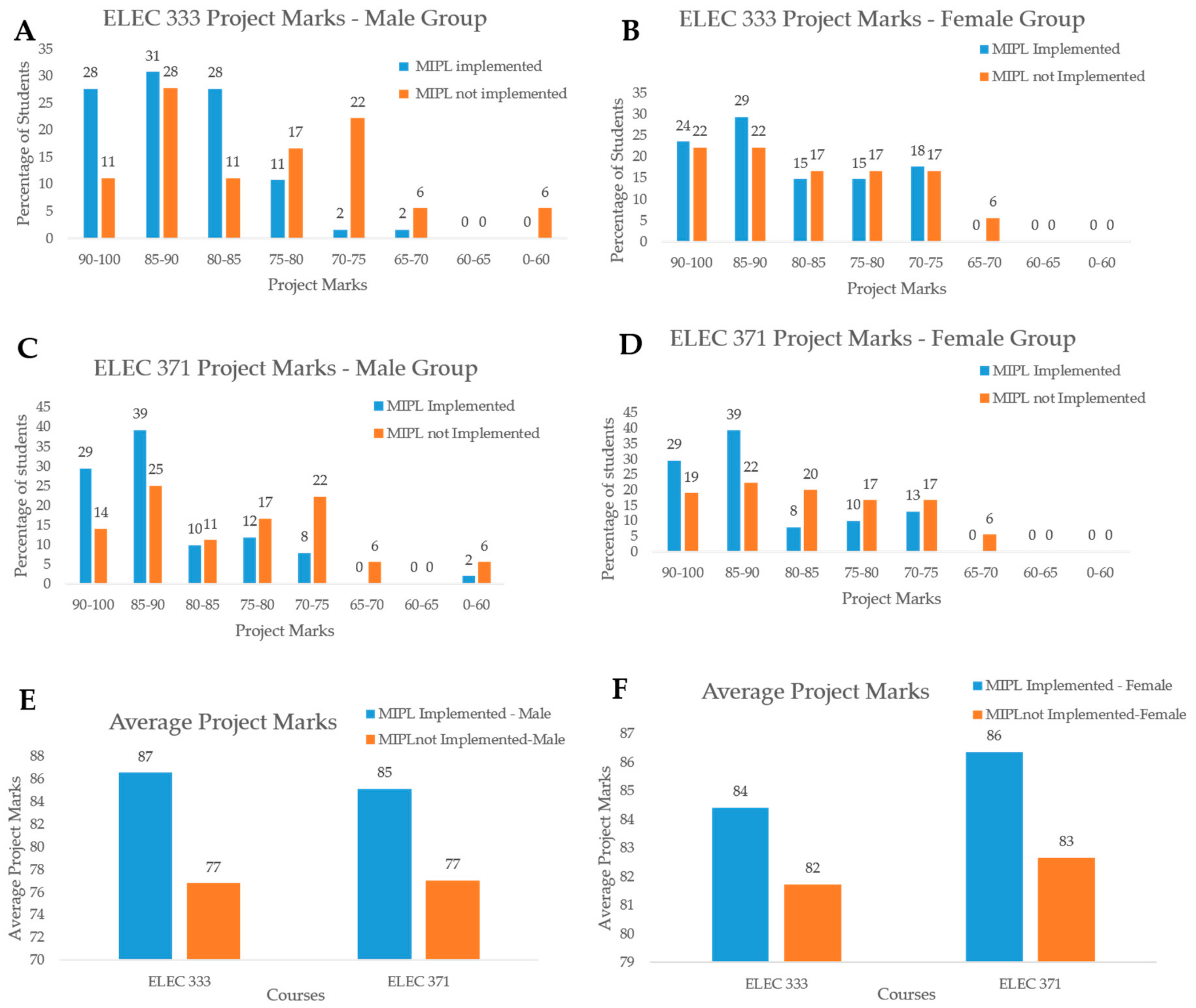

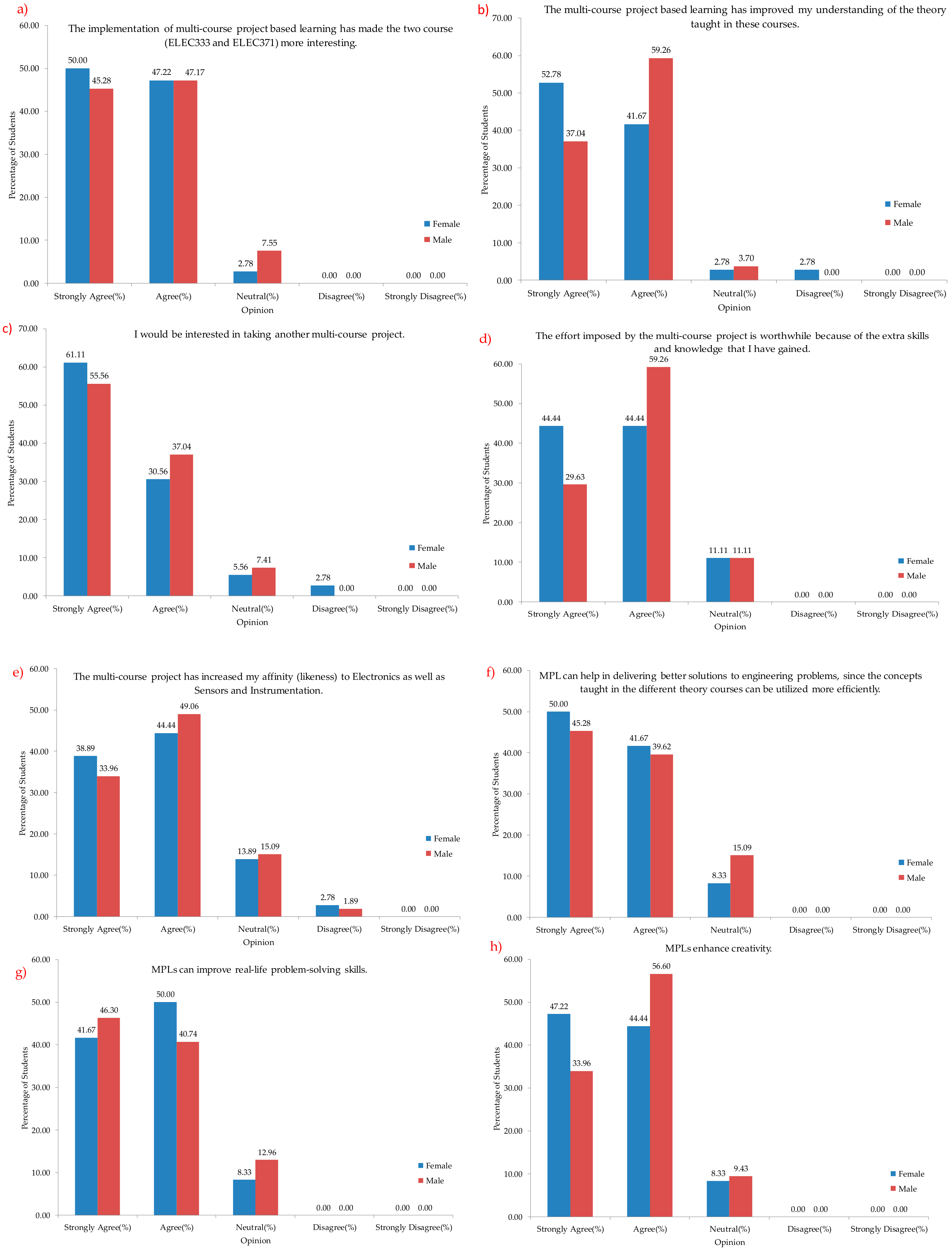

| Questions Statements |
|---|
| 1. The implementation of multicourse project-based learning has made the two courses (ELEC333 and ELEC371) more interesting. |
| 2. The multi-course project-based learning has improved my understanding of the theory taught in these courses. |
| 3. I would be interested in taking another multi-course project. |
| 4. The effort imposed by the multi-course project is worthwhile because of the extra skills and knowledge that I have gained. |
| 5. The multi-course project has increased my affinity (likeness) to electronics as well as sensors and instrumentation. |
| 6. MPL can help in delivering better solutions to engineering problems since the concepts taught in the different theory courses can be utilized more efficiently. |
| 7. MPLs can improve real-life problem-solving skills. |
| 8. MPLs enhance creativity. |
| 9. MPLs improve teamwork skills. |
| 10. MPLs can develop independent learning skills. |
| 11. MPLs require students to think differently from the typical classroom way. |
| 12. Having laboratory sessions dedicated to advising students regarding the progress of their multi-course projects have helped them in improving their solutions, skills, and knowledge. |
| 13. The resources available at the laboratory were sufficient for completing the multi-course based project. |
| 14. In the MPL study, project topics given were diverse and interesting. |
| 15. The MPL approach should be used in other courses too. |
| Question Statement | Prediction | Accept or Reject Based on the Chi-Square Analysis (chi − square critical value = 9.49 with Degree of Freedom = 4, α = 5%) |
|---|---|---|
| The presence of a multi-course practical project has made the two courses (ELEC333 and ELEC371) successful and more interesting. | Almost all the students should strongly agree with this statement | Thus, Do Not Reject |
| The multi-course project-based learning has improved my understanding of the theory taught in these courses. | Almost all the students should strongly agree with this statement | Thus, Do Not Reject |
| I would be interested in taking another multi-course project. | Almost all the students should strongly agree with this statement | Thus, Do Not Reject |
| The effort imposed by the multi-course project is worthwhile because of the extra skills and knowledge that I have gained. | Almost all the students should strongly agree with this statement | Thus, Do Not Reject |
| The multi-course project has increased my affinity (likeness) to electronics as well as sensors and instrumentation. | Almost all the students should strongly agree with this statement | Thus, Do Not Reject |
| MPL can help in delivering better solutions to engineering problems since the concepts taught in the different theory courses can be utilized more efficiently. | Almost all the students should strongly agree with this statement | Thus, Do Not Reject |
| MPLs can improve problem-solving skills. | Almost all the students should strongly agree with this statement | Thus, Do Not Reject |
| MPLs enhance creativity. | Almost all the students should strongly agree with this statement | Thus, Do Not Reject |
| MPLs improve teamwork skills. | Almost all the students should strongly agree with this statement | Thus, Reject One of the student learning outcomes of the electrical engineering program is to promote teamwork. Thus, this aspect should be enhanced while designing the project next time it is offered. |
| MPLs can develop independent learning skills. | Almost all the students should strongly agree with this statement | Thus, Reject if we do the chi-square analysis for all students but Do Not Reject if we do it separately for male and female students One of the student learning outcomes of the electrical engineering program is to develop independent learning skills. Thus, this aspect should be enhanced while designing the project next time it is offered. Male students believe that it helped in independent learning skills whereas female students were not completely convinced. |
| MPLs require students to think differently from the typical classroom way. | Almost all the students should strongly agree with this statement | Thus, Do Not Reject |
| Having laboratory sessions dedicated to advising students regarding the progress of their multi-course projects have helped in improving their solutions, skills, and knowledge. | Almost all the students should strongly agree with this statement | Thus Do Not Reject |
| The resources available at the laboratory are sufficient for completing the multi-course projects. | Almost all the students should strongly agree with this statement | Thus, Reject This aspect has to be also taken into consideration when implementing such initiatives. |
| In the MPL study, project topics given are diverse and interesting. | Almost all the students should strongly agree with this statement | Thus, Reject if we do the chi-square analysis for all students but Do Not Reject if we do it separately for male and female students This aspect has to be also taken into consideration when proposing the project titles to the students in the following semester. |
| The MPL approach should be used in other courses too. | Almost all the students should strongly agree with this statement | Thus, Do Not Reject |
© 2020 by the authors. Licensee MDPI, Basel, Switzerland. This article is an open access article distributed under the terms and conditions of the Creative Commons Attribution (CC BY) license (http://creativecommons.org/licenses/by/4.0/).
Share and Cite
Khandakar, A.; Chowdhury, M.E.H.; Gonzales, A.J.S.P.; Touati, F.; Emadi, N.A.; Ayari, M.A. Case Study to Analyze the Impact of Multi-Course Project-Based Learning Approach on Education for Sustainable Development. Sustainability 2020, 12, 480. https://doi.org/10.3390/su12020480
Khandakar A, Chowdhury MEH, Gonzales AJSP, Touati F, Emadi NA, Ayari MA. Case Study to Analyze the Impact of Multi-Course Project-Based Learning Approach on Education for Sustainable Development. Sustainability. 2020; 12(2):480. https://doi.org/10.3390/su12020480
Chicago/Turabian StyleKhandakar, Amith, Muhammad Enamul Hoque Chowdhury, Antonio Jr. San Pedro Gonzales, Farid Touati, Nasser Al Emadi, and Mohamed Arselene Ayari. 2020. "Case Study to Analyze the Impact of Multi-Course Project-Based Learning Approach on Education for Sustainable Development" Sustainability 12, no. 2: 480. https://doi.org/10.3390/su12020480
APA StyleKhandakar, A., Chowdhury, M. E. H., Gonzales, A. J. S. P., Touati, F., Emadi, N. A., & Ayari, M. A. (2020). Case Study to Analyze the Impact of Multi-Course Project-Based Learning Approach on Education for Sustainable Development. Sustainability, 12(2), 480. https://doi.org/10.3390/su12020480






